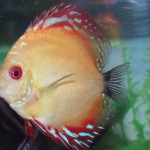Even though it is possible to have fish without knowing their pH tolerances there are certain fish, typically of the more exotic breeds, that require specific pH balances to be able to live inside the water of the aquarium. Understanding how the pH of your tank works, as well why the different reactions that can occur happen, leads to having a healthy aquarium with happy fish.
The pH level of the water in your aquarium is determined essentially by measuring the difference in the ions H+ and OH-, with knowledge of how these two ions regulate the acidity of the tank. Ions are a combination of two other molecules that results in a particle with a charge, and ions in particular are formed by the binding of two other molecules positive electrons and negatively charged neutrons. All atoms are surrounded by electron containing layers, with the innermost containing 2 electrons and next layer containing 8.
The components of water, hydrogen and oxygen, are atoms that have strong reactions to one another due to their unique math. Hydrogen contains 1 electron and needs one more to reach the optimum number of its inner shell – 2 – that an atom wants to have. Oxygen has 8 total electrons, but only 6 in the outer layer which means that oxygen desperately wants to bind with other atoms gain two electrons. Thus, oxygen reacts with two hydrogen in an ionic bond to form H2O -common water. When only a single oxygen and hydrogen come together they, instead of water, form OH- which is hydroxide. Typically, the lone H+ will bind with a formed water molecule to form H3O+, which is what is measured to determine pH. The more H3O+ molecules, the lower the pH of the tank.
The pH scale ranges from 1-14 with 1 being acidic, 7 being considered neutral, and 7+ being referred to as a base, or alkaline. The pH scale constantly changes as new materials are introduced into the water both by human hands and as natural products from the contents of the aquarium. Rapid shifts in pH are what is actually harmful to the fish due to their bodies being unable to cope quickly enough. Although rapid shifts in pH are harmful, most fish can live in pH conditions, that even if not the ideal levels, are at least a stable acidity.
Ideally, you will want the keep the tank in the 7 – 7.5 pH range as this is close to being neutral while not being too inhospitably alkaline. You can adjust the levels of the tank naturally by adding limestone to raise alkalinity and peat moss to raise the acidity of the tank. Make sure to monitor the pH level of your aquarium to keep your fish healthy and happy.
















